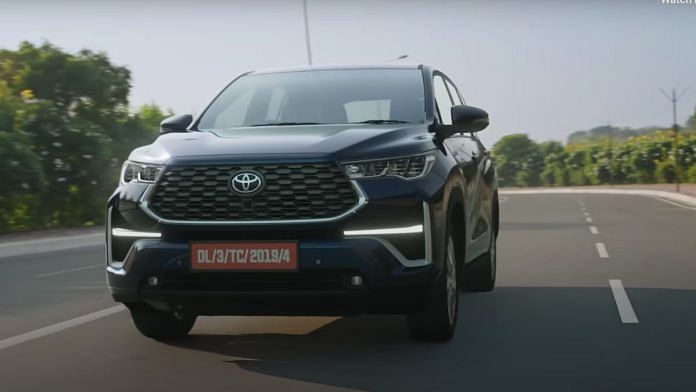If you were to walk into a Toyota showroom to order a new Innova Hycross, you might leave disappointed. This relatively new vehicle from the Japanese carmaker has one of the longest waiting periods. A booking today might mean a car delivered only in early 2025.
There are a lot of reasons for this delay, the enduring popularity of the Innova, now in its third generation — not just with taxi operators but also among families. While the Innova is sold as a regular petrol car, and Toyota still offers the old Crysta with a diesel motor, the popularity of the new version seems to have taken the company by surprise.
Vikram Gulati, Country Head, Toyota Kirloskar Motor (TKM), the Indian subsidiary of the Japanese carmaker, tells me that they are ramping up production by 30 per cent to be able to meet the additional demand for the car. Yet, with TKM committed to provide a certain volume of production to their partner Maruti-Suzuki (their version of the Innova will be called the Invicto and is nearing the launch), the increase in output might only make a small difference in the short-term.
“Increasing production is not like turning on a tap,” Gulati laments, saying he wished he could “fulfil the demand for the Innova…when we increase production, even the smallest component manufacturer in our system has to ramp up their production.” The automotive industry in India seemed to be unprepared for the post-Covid bounce in sales, and while top-tier manufacturers might not be enduring manpower issues, component makers are having troubles.
“There is a clear shortage of trained manpower in the manufacturing sector,” Gulati says, adding that since 2007, TKM has been playing their role in improving the situation by running a three-year residential vocational training programme at their manufacturing site at Bidadi outside Bengaluru. “We have trained close to 80,000 youngsters and some of them work on our plant, others have been employed by automotive companies across India.” Also, the shortage of certain vital components such as semiconductors impacted cars adversely.
The new Innova features a hybrid and demand for these powertrains is gaining popularity in the market. Toyota Hyryder and its Maruti-Suzuki sibling, the Grand VItara are also selling large numbers of Hybrids. “In markets like the National Capital Region (NCR) where buying a diesel vehicle is pointless for many because of the ten-year rule, Hybrid vehicles offer a high degree of fuel efficiency, similar to that of a diesel while not costing all that much more,” says Gulati.
After having driven both the Hyryder and Grand Vitara in and around the Delhi-NCR for almost a month in total, along with Honda City e:HEV, which is also a Hybrid, a simple fact becomes apparent. The Hyryder and Grand Vitara despite being compact Sports Utility Vehicles easily deliver over 23 kilometres per litre. On online motoring forums, Hybrid owners compete with each other in claiming to eke out the maximum from each litre of petrol. And the better the fuel economy, lower the emissions. Most average buyers are claiming close to 25 kilometres per litre, more than double what a regular petrol vehicle would deliver.
Stressing on the efficiency of Hybrids, a technology that Toyota made popular with the Prius over two decades ago, Gulati links it to emissions, saying that motor vehicles ought to be taxed on the basis of overall emissions rather than the government pushing one technology solution over another. Toyota, for example, has been slow to pivot toward full battery-electric vehicles and the carmaker has a few in the pipeline, maybe even for India. Gulati, however, talks about the geopolitical risks of battery-electric vehicles: “India wants to reduce dependence on oil imports, which is fair, but we should look carefully at the electric vehicle supply chain as well.”
Also read: EVs are duping you about carbon emissions. Govt should let diesel cars run longer
In fact, he holds out immense hope for Hydrogen as a fuel for future vehicles, particularly Hydrogen Internal Combustion Engines (Hydrogen-ICE). This, according to him, would be a technological progression from current ICE vehicles although major modifications will be required to the engine and fuel-system. “The push for Green Hydrogen by the Government of India is extremely positive, and it holds out hope that there might be multiple paths toward the ultimate goal of reduced emissions and reducing oil imports.”
As for now, Gulati is still fending off requests from friends for expedited deliveries for the Innova Hycross.
@kushanmitra is an automotive journalist based in New Delhi. Views are personal.
(Edited by Anurag Chaubey)



